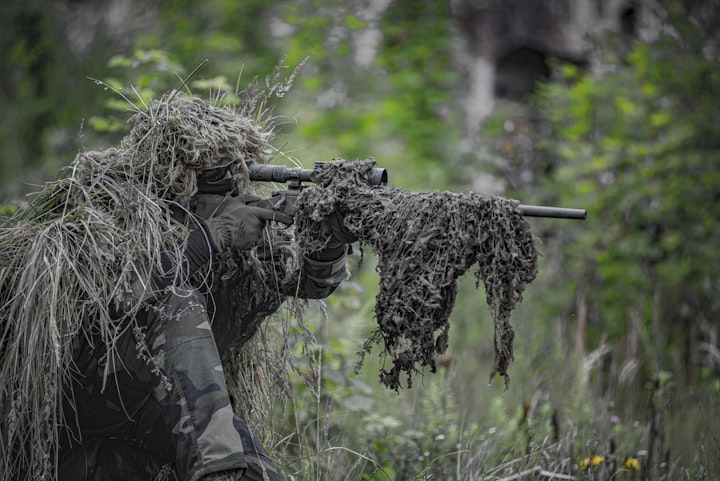
Camouflage has been all over mass media since the beginning of the war in Ukraine, demonstrating how vital camouflage is, regardless of technological advancement.
Russia has established air supremacy over Ukraine. Because NATO or the United Nations would not intervene and close the sky, the Ukrainians on the ground had no choice except to use good old camouflage to evade air attacks.
Infantry-wise, every soldier knows how camouflage saves lives. Camouflage can keep you safe and out of sight, which is how you win the battle. It's not just putting on face paint and camo pants. You can use camouflage strategically to hide from your enemy, as you will watch below in recent footage from the Ukrainian side.
The key to making it as a soldier is recognizing that camouflage isn't just about what you wear but how it is used and helps your overall performance.
Camouflage: learn the basics
Camouflage aims to blend into the surroundings so that you are hard to see and destroy, both from a distance and up close.
To do this, you need to understand camouflage in relation to how the human eye sees something. The brain decides what it sees based on how light falls on something (measurements referred to as hue, value, and chroma).
If your clothes don't match the background, or if they create a contrast with it, your brain can instantly put two and two together and figure out that a soldier is hiding in the bushes.
Personal camouflage
The key to camouflage is blending in with your surroundings. The more you blend in, the harder it will be for the enemy to spot you. This is important because if an enemy can't see you, they can't shoot at you.
You blend in by using the environment to your advantage. This can mean using sticks, branches, leaves, and other natural objects to hide your body shape or look like something else. It can mean using the shadows or light around you to make yourself hard to see.
It can even mean positioning yourself so that a rock or fallen tree blends into part of your body outline and makes it look as though there's just a rock or tree stump where someone might have thought they saw a soldier crouching down behind some shrubs.
It may also help to disguise your face if possible by covering it with dirt, oiling it up, so it reflects less light, or simply changing its outline so that it doesn't stand out as much.
Consider going old-school with leafy camo. This is an excellent option if you find yourself in a wooded area or jungle, as the natural variety of the foliage makes for easy camouflage.
The key to it is ensuring that leaves are fresh and haven't dried out yet. If you're looking to use real leaves, try to pick them from trees and plants with large canopies so as not to deplete their environment too much.
After coming up with an idea for hiding yourself from prying eyes, always test it out first before putting all of your faith into making sure that nobody sees through whatever ruse you've decided upon.
Camouflage netting
Camo netting is a fabric used by the military to conceal equipment, military vehicles, and troops from enemies.
It's made with an irregular pattern that helps break up the visual outline of what's covered by the netting. Camouflage netting is typically made of nylon, polyester, or cotton.
Know the terrain before picking a camo pattern
The first thing to know about camouflage is that it's not just black and gray. Camouflage has several other hues, from green to brown - and even orange. The best way to determine what color you're looking for is by looking at your surroundings.
Are there natural objects in the area that might provide helpful contrast? Can you make out shapes and edges? Getting these details right will help you select an effective pattern for your needs.
Finding a camo pattern that suits your needs isn't hard at all; there are plenty of options available. Once you've picked your pattern out, consider matching it with one or more of your accessories.
If you're moving in an open area with grassy plains and clear skies, for instance, you might want to choose an all-over pattern that mimics the sky.
A cloudy day is best for these patterns because they'll blend in with the greyish palette of cloud cover.
On a blue-sky day, the contrast between your clothes and the sky will make you stand out and thus give away your position to other hunters or game.
Get down and dirty
Dirt and mud can add great texture to your camo patterns.
When it comes to camouflage, the best possible way to sustain a disguise is to look like you were born there. Mud and dirt are both natural elements that can be used to make your camouflage more effective, but more importantly, they can also help you blend in with your environment.
A well-mixed mixture of dirt and water is excellent for camouflaging an object or person. Mud has remarkable properties as a camouflage: it absorbs light waves and reflects them like a mirror, making its features difficult for the human eye to pick out.
This characteristic makes mud ideal for hiding objects in plain sight or giving them an interesting texture when they're standing still. Mud can be mixed with several other ingredients that'll affect how it looks and what kind of effect it has on the environment.
Just remember: too much mud will mess up the shape of your object! It's fine if some parts are slightly off-center, but consider using slightly smaller portions than you think you need if there's too much mud or if you want your pattern to be super simple.
Painting your face
Keep your face paint plain if you want to be as stealthy as possible. In the army, camouflage face paint is applied in a pattern to allow soldiers to better blend in with their environment.
Face paints are often available in shades of neutral colors like tan, green, or brown. You can purchase an inexpensive makeup palette that contains these colors from most department stores that sell cosmetics.
To make sure you are blending in correctly, it's best to apply your camouflage face paint in a darkened room using a mirror so you can see where the colors need to be applied most.
The more color and shadows that show up on your face while you're wearing the camouflage face paint, the more likely it is that people will be able to tell that there's something off about what they're seeing.
Painting your hands
Once you already have your camouflage colors on your face and neck, it's time to move on to the hands. Here's a step-by-step guide for painting your extremities:
To ensure that the paint stays on your hands and doesn't leave unsightly smudges everywhere you touch things, use a small amount of soap or water to clean them first. This will remove any dirt or grease that could impede how well the paint adheres.
Next, apply a layer of olive green (or other neutral colors) first all over your palms and backs of both hands (but not in between fingers).
When that layer is dry, add some more olive green around the wrists and at the base of each finger.
Now it's time for some brown! Apply this color under each finger instead of between them since this area is more likely to be visible when you're hiding in a bush than all ten fingertips together would be.
Finally, go over everything with either whatever shade you used as a neutral earlier or with black if you have it handy - this will help blend all those edges together, so they don't look unnatural once they're camouflaged!
With the side of your hand, rub a thick layer of paint onto your face in small circles. Remember to be thorough - make sure you get both sides of your nose and ears and avoid leaving any discernible lines between applied areas.
A note on ears: While you don't want to forget them, you also don't want to go too heavy with the paint here. You have much thicker skin on this part of the body than in other nearby areas; since it won't absorb as well, it will look uneven if you use too much paint.
A step-by-step guide to camouflage tactics
- You'll have to pick a location.
- You'll need your materials.
- Practice applying the camo in several scenarios.
- Try it out in the wild.
- If you're part of a team, apply the camouflage to everyone in the squad.
- Coordinate your movements and positioning with your teammates.
- You can create a nearby distraction for your enemy.
- Wait for it!
Closing note
You can create a pro-level camouflage outfit yourself with the right tools and some practice.
_____________
Thanks for reading this article. Please consider supporting our community of creators by becoming a Vocal+ Member. Feel free to come back at any time and pick up another thread from my Vocal book of content. Small tips, pledges, and big hearts are highly appreciated. Till next time, cheers. - Rui
About the Creator
Rui Alves
Hi, I'm Rui Alves, a teacher, army veteran & digital pathfinder. Author, alchemist of sound & Gen-AI artist.
Reader insights
Nice work
Very well written. Keep up the good work!
Top insights
Expert insights and opinions
Arguments were carefully researched and presented
Eye opening
Niche topic & fresh perspectives
Heartfelt and relatable
The story invoked strong personal emotions






Comments
There are no comments for this story
Be the first to respond and start the conversation.